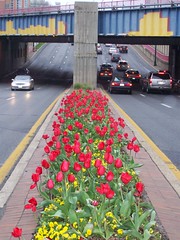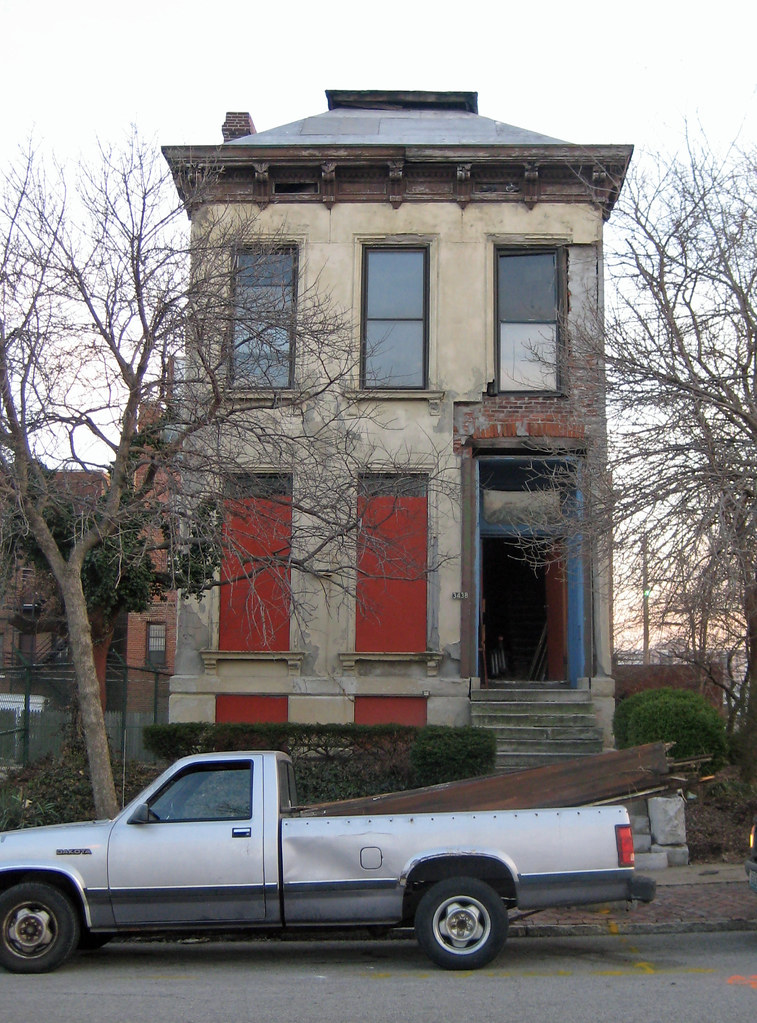Unconscionable. St. Louis University continues to deface the built environment and derail the very stability they’re typically credited with bestowing upon the Midtown and Grand Center neighborhoods. The latest victim of SLU’s parking preference is the demolition of the Wagner House at 3438 Samuel Shepard, as reported first by
Vanishing STL. (The photographs below are all property of Vanishing STL.)
I call it the “parking preference” because parking lots, chiefly, and garages, secondarily, receive preferential treatment among land uses by officials at St. Louis University.
The Wagner House is one of the few remaining row houses in St. Louis’s central corridor. If within a series of intact rows, this structure on Samuel Shepard would have appeared a member of a stately block more typical of urban Brooklyn than somewhat spread-out St. Louis.
But SLU has been given a pass by an unwitting or indifferent public. Typically, you will hear the remark that the university "saved" Midtown and that there's simply no saying what the neighborhood would be like without the strong institutional anchor that is SLU. Father Lawrence Biondi, S.J. (President of SLU) was even named "Citizen of the Year" in 2005 by a group of former recipients who had received the award themselves for demonstrating "concern for St. Louis' growth and vitality," presumably for redevelopment efforts and those same attributions of SLU to the health of Midtown.
Yes, there's the Moolah, the Continental Life Building, the Coronado, and the Warehouse of Fixtures that all saw rebirth either on direct or indirect account of SLU's presence. The importance of each one of these buildings cannot be overstated.
And yet, as always, it's the architectural "little guy" that's allowed to atrophy: the one that's off the beaten path; the one that's been vacant for years; the one that's stately but not imposing; the one that it takes just an ounce of vision to respect and recognize that it is vital to the future of its home block. Perhaps, more simply, the one that's on a small enough scale to easily demolish.
While I would argue the Wagner House is a profound, elegant example of a limestone faced Italianate Row House, it still appears quite forlorn as a vacant building on a street now sadly devoid of almost any residential use (one of the many of that type found in St. Louis's illustrious and almost single-use arts district, Grand Center).
The cycle takes one step further here. With each footing of urbanity lost, another demolition is justified. The loss of the Livery Stable just to the east in the burgeoning Locust Business District quite likely represented a vindictive land grab by a powerful institution with a pretty public face. The turn of the century historic building was felled for a surface parking lot--in 2007 (this century)--all to serve the rather distant new SLU sports arena on Compton. The June 20, 2007 Riverfront Times Article "Rebuilt to Suit" is an illuminating investigative piece on SLU's bullying of business district entrepreneurs in order that they might demolish the very stock of buildings that makes the district a prime candidate for reinvigoration and is the only hope of an adjacent, pedestrian-friendly retail area to serve the university.

The salt in the wound is that SLU represents a top-down planning approach inspired by the Urban Renewal mentality that awarded them half of their campus's land--an approach diametrically opposed to the smaller scale, more organic approach of the Locust Business District and its associated partners.
Thirty-seven forty Lindell, right on SLU's campus, was also lost, this time to plans for a new law school:
[Edit (3/20/08): Just drove by the site today. Woops! Didn't realize this building was still up. I'm pretty sure that SLU's plans are still to tear it down for the new law school.]
Without going into SLU's more distant past of demolitions, the case can be made that SLU is a detriment to the neighborhood in which it is situated for no greater reason than that it has effectively dismantled whatever neighborhood existed.
If the argument is whether SLU has presented an economic boon to the city, then I would argue on the side that it is very beneficial for the city. Does that mean it's been kind to its neighbors? Not at all. In fact, if SLU were in a preservation-friendly neighborhood that would have reigned in its quest to acquire land for new construction at any cost, we might have seen a mutual benefit, a kind interplay between institution and neighborhood that can prove a best case scenario. Tulane and Loyola Universities in New Orleans, while not perfect, are good examples of universities that remained sensitive and complementary to historic neighborhoods and their unrivaled amenities: historic buildings and lively public spaces.
A friend of mine here in New Orleans comes to mind. She was speaking on her neighborhood association--located in a very stable, middle class Uptown enclave--and its responsibilities. I inquired as to what major concerns the neighborhood, called Touro after its institutional anchor (a healthcare facility), has.
Bluntly, she responded, "Well, sometimes the hospital's an asshole."
As a struggling city, St. Louis must not fear to oppose its institutions, which should be lifebloods rather than bloodletters, when they are, in fact, being assholes.
And, of course, please contact 19th Ward Alderperson Marlene Davis and let her know your concerns over this demolition.














